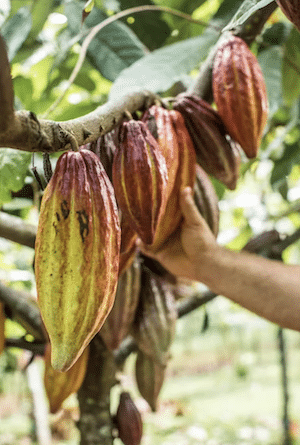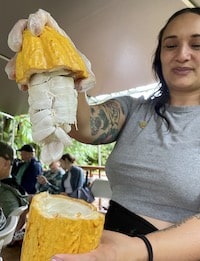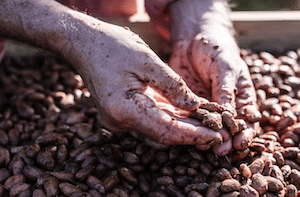 “If everything goes as planned, there would be no story,” my husband often says. It also means that I would not be writing this story! Following our halfway Thanksgiving meeting point in Kona, Hawaii, with our niece (who lives in New Zealand), we headed to Kauai for some hiking. However, the predicted seasonal weather of rain prevailed, creating muddy pathways, cancelled reservations and a Plan B, which led us to check out local agriculture and food opportunities.
“If everything goes as planned, there would be no story,” my husband often says. It also means that I would not be writing this story! Following our halfway Thanksgiving meeting point in Kona, Hawaii, with our niece (who lives in New Zealand), we headed to Kauai for some hiking. However, the predicted seasonal weather of rain prevailed, creating muddy pathways, cancelled reservations and a Plan B, which led us to check out local agriculture and food opportunities.
While farm visits and numerous photos of “what’s growing in the fields” are common practices whenever and wherever I travel, discovering a farm that grows something I didn’t know existed in the U.S. was a new experience. While we may think cacao trees exist only in West Africa, a visit to the Hawaii Islands and Lydgate Farms proved otherwise. There’s nothing like a few rain drops to drive you to experience the world of cacao production and tasting chocolate!
The North Pole of Cacao
Even though I had been to Hawaii previously, I never thought about their agriculture production beyond pineapples and cattle. But the Islands are tropical and sit in a unique region.
To “grow” chocolate (cacao trees), a humid tropical environment is necessary, but those locations are limited to a width of land that stretches 10 degrees on either side of the equator with a temperature range of 65 to 90 degrees. This is why 70% of the world’s cocoa beans come from four West African countries: Ivory Coast, Ghana, Nigeria and Cameroon.
Hawaii, sitting 20 degrees north of the equator at the extreme point of the tree range, is the coldest place in the world where cacao can grow. Hence the name, the North Pole of Cacao. But while the “cold” environment demands additional production methods, it also produces high quality chocolate.
Hawaii Chocolate — What is Old Is New Again
 Cacao plants are not native to the Hawaii Islands. History reflects that the first documented cacao tree was in King David Kalakaua’s garden, having been imported from Guatemala. But it wasn’t until the mid 1800s that interest grew when a German physician William Hillebrand planted cacao trees in Honolulu. Over the next 50 to 60 years, cacao farms were started across the islands, reaching their peak during World War I when global shipping disruptions benefited the Hawaii market and created premium cocoa prices. However, the price points were short lived, and the financial realities did not support continued production.
Cacao plants are not native to the Hawaii Islands. History reflects that the first documented cacao tree was in King David Kalakaua’s garden, having been imported from Guatemala. But it wasn’t until the mid 1800s that interest grew when a German physician William Hillebrand planted cacao trees in Honolulu. Over the next 50 to 60 years, cacao farms were started across the islands, reaching their peak during World War I when global shipping disruptions benefited the Hawaii market and created premium cocoa prices. However, the price points were short lived, and the financial realities did not support continued production.
It wasn’t until the 1980s and 1990s, that cacao “farming” was initiated again through a venture supported by Hershey Chocolate. Even though the planting of 18,000 cacao trees 40 years ago did not prove to be initially successful, it is the backbone of today’s small-scale growers and craft chocolatiers who once again are putting Hawaii on the map for sustainable and high-quality chocolate.
Lydgate Farms — Connecting the Generations
The Lydgate Farms story mirrors the introduction of chocolate to Hawaii as the original Lydgate, the great-great-grandfather of current owner Will Lydgate, arrived in Hawaii during the mid 1860s. As an engineer and millwright, his interests extended beyond his profession, planting the family’s first agricultural roots in sugarcane. His son, J.M., a botanist and avid protector of the land, started the family connection to chocolate while working with Dr. Hillenbrand on his botanist endeavors including cacao trees.
It wasn’t until the late 1990s, when Will and his father bought some rough land and planted cacao trees. Ten years later, they celebrated their first harvest. Will has noted in publications that the learning curve was steep but hard work and commitment to sustainable agriculture practices have produced dividends. Three times, in 2017, 2021 and 2023, Lydgate Farms has been recognized as one of the top 50 cacao bean growers in the world in a global competition by the Cocoa of Excellence.
Three Hours of “Heaven”
Will Lydgate was one of the first cacao growers to initiate the “tree to bar” farm tours, an experience that truly embodies the farm’s commitment to product quality and sustainable production.

A Drop of Sweat in Every Bite
Cacao production is like every farming endeavor; there is a lot of sweat equity in the finished product. But cacao also has some unique nuisances:
1. Unlike vegetables or row crops that produce a sellable crop within months of planting, it takes 5 to 7 years before a cacao tree produces fruit (cacao pods) that can be harvested. Once maturity is reached, trees will produce fruit at least twice a year, up to 20 plus years if diseases don’t attack.
2. Cacao pods must be harvested by hand to preserve the fruit. While it’s labor intensive for the small growers in Hawaii, it pales to the labor required in the major cacao production countries, Hence, why the labor issues exist in the West Africa countries.
3. It takes lots of trees to make chocolate! Each tree produces an average of 30 pods with 30 to 40 beans per pod. It takes 400 beans to produce one pound of cocoa! One cacao tree produces approximately three pounds of cocoa.
4. Chocolate is a processed food. The finished product we enjoy is achieved after the beans are fermented, dried, roasted, cracked and ground and the chocolate liquor (liquid) is extracted. Due to the colder climate, Hawaii cacao farmers spend around 5-10 days fermenting the beans, which is much longer than the industry standard but produces a less bitter taste.
5. Upcycling the whole cacao is more than just a trend. Lydgate Farms makes products that extend beyond chocolate including two made from the roasted cacao bean shells: Brewing Chocolate and Cacao Tea. Fruit pops made from the cacao pulp also are available at the farm.

Whether your travels go as planned or not, find the story around you. Every community, region or country grows and produces food that is unique. Whether it’s financial, environment or social influences, there is always a “why.” Even when it “rains on our parade,” we can learn to find the rainbow. This can lead to a blissful adventure … and perhaps some delicious chocolate!
References
- Lydgate Farms
Note: You can always have a little Hawaiian chocolate delivered to your door! - “How long does it take to grow a cacao tree?” CocoTerra, February 19, 2023.
- “Hawaii: The North Pole of Cacaol,” ecolechocolat blog’s bean2bonbon.
- Hawaii Chocolate and Cacao Association
- “How Hawaii Became the North Pole of Cacao,” by Jennifer Billoc, Smithsonian Magazine, February 14, 2018.
- “Meet the Hawaiian cacao farmer working to change the chocolate industry,” by Heather K. Scott, Feast and Field, February 14, 2022.
- “Whole Foods Market Forecasts Top 10 Food Trends For 2024,” by Claudia Alarcón, Forbes, October 19, 2023.
